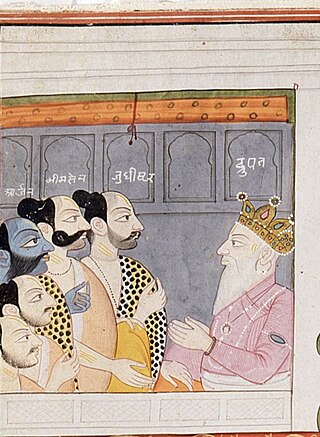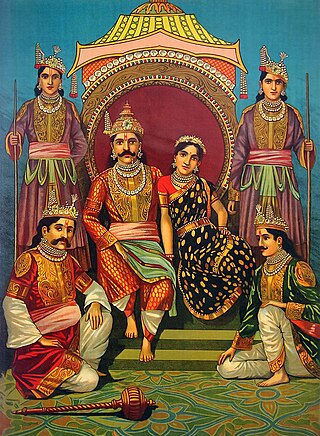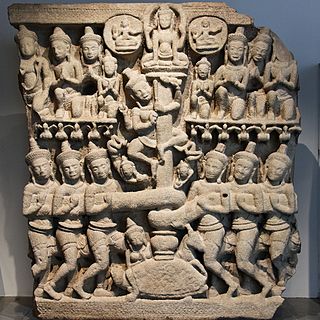
Draupadi, also referred to as Krishnā, Panchali, and Yajnaseni, is the main female protagonist of the Hindu epic Mahabharata, and the wife of the five Pandava brothers—Yudhishthira, Bhima, Arjuna, Nakula, and Sahadeva. She is noted for her beauty, courage, and polyandrous marriage.

Droṇa, also referred to as Dronacharya, is a major character of the Hindu epic Mahabharata.

Drupada, also known as Yajnasena, is the king of the southern part of Panchala Kingdom, in the Hindu epic Mahabharata. He is the father of Draupadi, the epic's lead female character. In the Kurukshetra War as the head of 1 akshauhini army, Drupada fought from the side of his sons-in-law, the Pandavas, and was killed by his childhood friend and rival, Drona.

Yudhishthira also known as Dharmaraja, was the king of Indraprastha and later the Kuru Kingdom in ancient Indian History and the eldest among the five Pandava brothers, he is also one of the central figures of the ancient Hindu epic Mahabharata.

In the Hindu epic Mahabharata, Nakula was the fourth of the five Pandava brothers. Nakula and Sahadeva were twins blessed to Madri, by the Ashvini Kumaras, the divine physicians and adopted by Pandu. Their parents – Pandu and Madri – died early, so the twins were adopted by their mother, Kunti and were trained by Drona in Hastinapura.

Shikhandi is a character in the Hindu epic Mahabharata. Born as Shikhandini, daughter of Drupada, the King of Panchala, Shikhandi becomes a biological male after agreeing to a sex exchange with a yaksha. He is the brother of Draupadi, the female protagonist of the epic, who is the common wife of the Pandavas.

The Kurukshetra War, also called the Mahabharata War, is a war described in the Hindu epic poem Mahabharata , arising from a dynastic struggle between two groups of cousins, the Kauravas and the Pandavas, for the throne of Hastinapura. The war laid the foundation for the events of the Bhagavad Gita.

Hindu mythological wars are the wars described in the Hindu texts of ancient India. These wars depicted both mortals of great prowess as well as deities and supernatural beings, often wielding supernatural weapons of great power. Hindu teachings prescribe war as the final option, to be employed only after all peaceful methods are exhausted. Participation in righteous war, or dharmayuddha, was said to be honourable and was a principal duty of the Kshatriya or the warrior varna, and victory in such wars was regarded as a matter of honour.

Jayadratha is the king of the Sindhu kingdom featured in the Mahabharata. He was married to Dushala, the only sister of the hundred Kaurava brothers. The son of the king Vriddhakshatra, he is killed by Arjuna. He has a son named Suratha.
The Panchala kingdom was one of the historical Mahajanapadas of ancient India. It was annexed into the Nanda Empire during the reign of Mahapadma Nanda. Ahichchhatra was capital of northern Panchala and Kampilya was capital of southern Panchala.
Kampil, historically known as Kampilya, is a town and a Nagar panchayat in Farrukhabad district in the Indian state of Uttar Pradesh. It is located about 45 km from Farrukhabad, and 55 km from Budaun. It is a very important place from a historical point of view.

Kunti, born Pritha, is a prominent figure in the Hindu epic Mahabharata. Recognized for her pivotal role as the mother of Karna and the Pandavas, the central protagonists of the narrative, she is depicted as possessing notable beauty, intelligence, and shrewdness.

The Bhishma Parva, or the Book of Bhishma, is the sixth of eighteen books of the Indian epic Mahabharata. It has 4 sub-books and 124 chapters.
The Drona Parva, or the Book of Drona, is the seventh of eighteen books of the Indian epic Mahabharata. Drona Parva traditionally has 8 parts and 204 chapters. The critical edition of Drona Parva has 8 parts and 173 chapters.
Ashwatthama, also referred to as Drauni, is the son of Drona and a major character in the Hindu epic, the Mahabharata.

The Sauptika Parva, or the "Book of the Sleepers," is the tenth of eighteen books of the Indian Epic Mahabharata. Sauptika Parva traditionally has 2 parts and 18 chapters, as does the critical edition.
Amba is a character in the Hindu epic Mahabharata. She is the eldest and most beautiful daughter of Kashya, the King of Kashi, and the sister of Ambika and Ambalika.
Uttamaujas and Yudhamanyu are two brothers from the Panchala kingdom featured in the Hindu epic Mahabharata. In some versions of the epic, they were the sons of Panchala king Drupada and thus the brothers of Draupadi. During the Kurukshetra War, they became the bodyguards of Arjuna and fought a battle against Duryodhana.
In the Hindu epic Mahabharata, Vrishasena was the eldest son of the warrior Karna and his wife, Padmavati. Along with his father, he fought in the Kurukshetra war from the side of the Kauravas and faced many prominent warriors like Upapandavas, Drupada, Dhrishtadyumna, Nakula, Sahadeva, Virata and many more.














